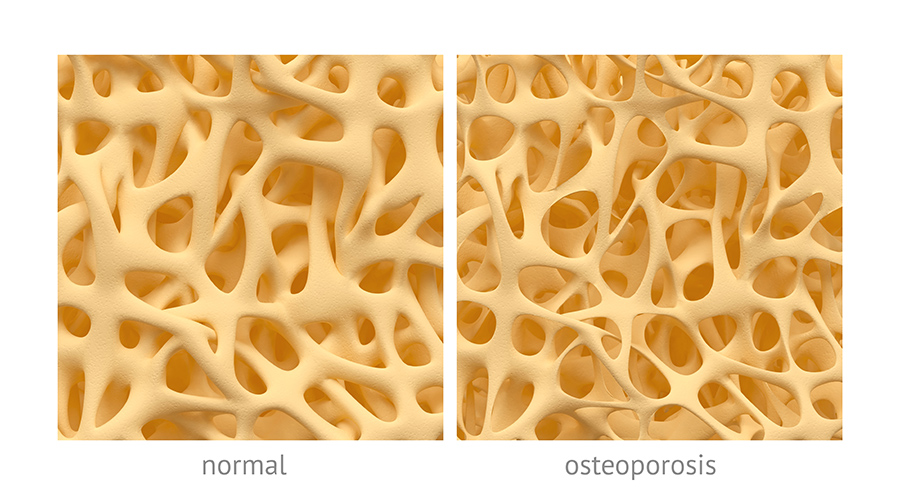Osteoporosis and Fragility Fractures

The purpose of this page is to provide information about osteoporosis so that you can better understand what it is, what causes it, how it's diagnosed and how to reduce your risks.
About osteoporosis
Osteoporosis is a skeletal disorder characterized by compromised bone strength predisposing one to an increased risk of fracture. Bone strength is a function of bone quantity and quality. As the density and quality of bones are reduced they become more porous and fragile, greatly increasing the risk of fracture.
The simulated images below show the difference between normal and osteoporotic bone under magnification.

- 10 million Americans have osteoporosis and an additional 43.1 million have low bone density. 1
- About one in every two Caucasian women will experience an osteoporotic-related fracture, as will one in five men in their lifetime. 2
- Every year there are 2 million fragility fractures caused by osteoporosis. 3
- Every year, of nearly 300,000 hip fracture patients, one-fourth end up in nursing homes and one-half never regain previous function.2
- Over 1/3 of patients with a hip fracture had a prior fracture. 4
References
1. Wright NC, Looker A, Suag K et al. The recent prevalence of osteoporosis and low bone mass based on bone mineral density at the femoral neck or lumbar spine in the U.S. J Bone Miner Res (2014)
2. Office of the Surgeon General (2014) Bone health and osteoporosis: a report of the Surgeon General. Rockville MD.
3. Burge R, Dawson-Hughes B, Solomon DH et al. Incidence and economic burden of osteoporosis-related fractures in the United States, 2005-2025. J Bone Miner Res 2007;22(3):465-475
4. Cummings SR, Nevitt MC, Browner WS et al. Risk factors for hip fracture in white women. NEJM 1995;223(12): 767-773
It is possible to diagnose osteoporosis using any of the following criteria:
- A DXA (Dual emission X-ray Absorptiometry) score lower than -2.5 in the total hip, femoral neck or lumbar spine
- When a fracture occurs from a fall from standing height or less, or if someone lifts something of 5 lbs or so and sustains a fracture in the proximal humerus, hip, spine, pelvis, and in some cases the wrist
- When a person has low bone density and the FRAX score (a World Health Organization tool to predict 10-year probability of major osteoporotic fracture in those with low bone density) shows an equal or greater 3% (hip) or 20% (major) 10-year fracture risk
A DXA or "Dual emission X-ray Absorptiometry" is a low dose x ray that distinguishes between bone and soft tissue. The exam is performed at the most common fracture sites: the femoral neck, total hip and lumbar spine. The exam is recommended for all women over 65 and men over 70, in postmenopausal women and men above age 50 based on risk profile, and in those same people who have had an adult age fragility fracture.
A T-score indicates how someone's bone mineral density compares to that of a healthy 30 year old. A score of less than -2.5 indicate osteoporosis and a score of less than 1.0 indicates low bone mass (sometimes called osteopenia).
- Eat a well-balanced diet with the recommended amount of calcium and Vitamin D, including bone-friendly foods such as fruits and vegetables
- Regular exercise including weight-bearing and muscle-strengthening exercises
- Avoid smoking and limit alcohol intake
- Maintain an appropriate body weight
- Avoid falls
- Get a DXA scan If you are a woman over age 65 or a man over age 70
What is a fragility fracture?
Fragility fractures are those that occur from a fall from standing height or less, or if someone lifts something of light weight (5 to 10 pounds) and sustains a fracture.
More than 2 million fragility fractures will occur this year, yet approximately 80% of these patients will not receive the recommended osteoporosis care following their fracture. A fragility fracture is the key predictor of future fractures. Patients who have a fragility fracture are at an 86% higher risk of a a second fracture.
According to the Clinician's Guide to the Prevention and Treatment of Osteoporosis "It has become increasingly clear that many patients are not being given appropriate information about prevention and many patients are not receiving appropriate testing to diagnose osteoporosis or establish osteoporosis risk. Most importantly, many patients who have osteoporosis-related fractures are not being diagnosed with osteoporosis and are not receiving any of the FDA-approved, effective therapies."
A fragility fracture is a distinctive symptom of osteoporosis. If you sustain a fragility fracture it is important that you take steps to treat your osteoporosis.
What you can do
- Call 503 494-4445 to schedule an appointment with OHSU's Orthopaedic Trauma and Fracture Care team for osteoporosis screening and treatment
- Read more about the connection between osteoporosis and fragility fractures and learn 7 smart steps to better bone health in our "Preventing Future Fractures" handout
- There are many other more complex medications that can be used to treat some patients with osteoporosis. This treatment is specialized for each patient and their individual medical history. We would be happy to discuss this further with you during an office visit
- Discuss osteoporosis with your primary care provider
- Eat a healthy diet with plenty of vegetables and fruit
- Get regular exercise - at least 30 minutes of weight-bearing exercise a day, five days per week
- Get enough calcium and vitamin D - talk with your health care provider about the appropriate dosage for you
- Don't smoke
- Limit alcohol intake
- Get your bone density checked
- Avoid falling - through exercise and balance training
- Learn more about osteoporosis
- OrthoInfo from the American Academy of Orthopaedic Surgeons
- 2 Million 2 Many
- Own the Bone